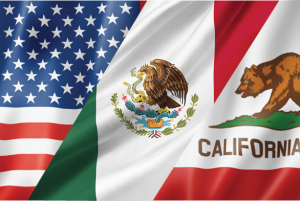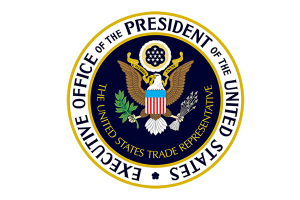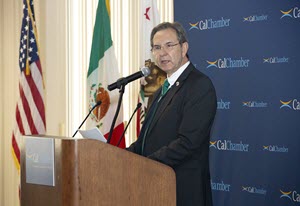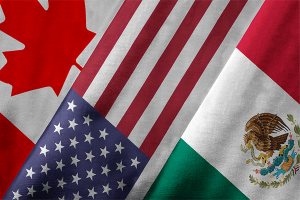North/South America Trade Relations
Region More Important Than Ever with Review of USMCA in 2026, Growing Chinese Influence
• The Western Hemisphere accounts for almost 34% of global gross domestic product (GDP).
• Almost 30% of total California exports are sent to the Western Hemisphere Central totaling $41.34 billion in 2023.
• The United States is the largest trading partner for all Latin America, but China is now South America’s largest trading partner due to investments in infrastructure throughout the region.
United States-Mexico-Canada Agreement
The four-year anniversary of the U.S.-Mexico Canada Agreement (USMCA) entering into force was July 1, 2024. In 2023, the United States exported more than $677.1 billion to USMCA countries, while California exported more than $52.64 billion.
The United States, Canada and Mexico comprise more than 500 million people (6.3% of the world’s population), a $29.15 trillion GDP (27.6% of world GDP), and $4.38 trillion in goods and services exports (nearly 14% of global goods and services exports). Under the USMCA, U.S. bilateral goods trade totaled $1.57 trillion in 2023.
U.S. Free Trade Agreements in the Americas
• The U.S.-Chile Free Trade Agreement (FTA) entered into force in 2004, eliminating tariffs and opening markets and allowing all goods originating in the United States to enter Chile duty free. Since the implementation of the FTA, U.S. goods exports to Chile have increased more than 421%. Chile is the 22nd largest export partner of the United States with exports totaling $18.7 billion in 2023.
In 2023, Chile invested $6 billion into the United States, an 8.8% increase, according to the Bureau of Economic Analysis, making it the seventh fastest-growing source of foreign direct investment (FDI) in the United States. California exports to Chile totaled $1.4 billion in 2023.
• The U.S.-Central American Free Trade Agreement (U.S.-DR-CAFTA) was signed by President George W. Bush in 2005. The governments of El Salvador, Guatemala, Nicaragua, Honduras and the Dominican Republic implemented the agreement in March 2007, followed by Costa Rica in 2008.
The United States and the five Central American countries share roughly $80.24 billion in total (two-way) trade in goods. U.S. goods exports to Central America totaled $45.15 billion in 2023. The United States is the main supplier of goods and services to Central American economies. Approximately 40% of total goods exports to Central America come from the United States.
California is the fourth largest state exporter to the DR-CAFTA market with exports totaling $2.87 billion in 2023.
In March 2024, Vice President Kamala Harris and the Partnership for Central America (PCA) announced more than $1 billion in new private sector commitments. As part of Central America Forward (CAF), the fund will go to invest in jobs, connecting people to the digital economy, providing training and education, and expanding financing. This brings total investment from new commitments to $5.2 billion since May 2021.
• The U.S.-Colombia Trade Promotion Agreement was signed by President Bush in 2006. It was approved by the Colombian Congress in 2007, but not approved by the U.S. Congress until 2011 and entered into force in May 2012.
Colombia is an emerging economy that is providing California with a quickly expanding export market and opportunity for future collaboration. Since 2006, both U.S. and California exports to Colombia have nearly doubled. In 2023, the United States exported $17.68 billion of goods to Colombia, with total trade amounting to $33.79 billion. In 2023, California exports to Colombia exceeded $514 million.
• A U.S.-Ecuador “mini” trade deal was signed in December 2020, bringing the two countries a step closer to achieving a free trade agreement. Ecuador is the only Latin American country along the Pacific Ocean that does not have a free trade agreement with the United States.
The United States exported $7.9 billion worth of goods to Ecuador in 2023 and imported $8.6 billion the same year. California is one of the top five exporting states to Ecuador, exporting $503 million of goods in 2023.
• The U.S.-Panama Trade Promotion Agreement went into effect in October 2012. The agreement significantly increased the ability of U.S. companies to export their products to one of Latin America’s fastest-growing economies. Half of U.S. agricultural goods became duty free at the time, with all tariffs on industrial goods to be eliminated by the 10-year anniversary and most of the remaining tariffs on agricultural goods to be eliminated by the 15-year anniversary in 2027.
In 2023, the United States exported $11.07 billion to Panama, making it the 32nd largest U.S. export partner. California exported $761 million worth of goods to Panama in 2023.
• The U.S.-Peru Trade Promotion Agreement entered into force in February 2009. U.S. exports to Peru have more than tripled since then, totaling $11.86 billion in 2023. California exports to Peru more than doubled during the same period, totaling $554 million in 2023.
Anticipated Action
It is hoped the Trump administration will continue to engage with Mexico and Canada, together with the nation’s trade and investment partners in Latin America — especially in light of China’s growing influence in the region.
It is also hoped that the continued success of the USMCA may serve as a foundation for future trade agreements.
Per a push by the first Trump administration in 2020, the USMCA will be up for review in 2026. Per the Brookings Institute, the 2020 USMCA will terminate 16 years after the date of its entry into force (that is, by July 1, 2036) unless each party confirms that it wishes to continue the agreement for a new 16-year term. The parties are to confirm their ongoing support for USMCA at a “joint review” by the Free Trade Commission, which comprises minister-level government representatives from each party. The first joint review is to take place on the sixth anniversary of entry into force of USMCA — which will be on July 1, 2026. At the joint review, the Commission will review the operation of USMCA.
The Commission can also “review any recommendations for action submitted by a party and decide on any appropriate actions. Each party may provide recommendations for the Commission at least one month before the Commission’s joint review meeting takes place.” Should the parties confirm in writing that they want to continue with the USMCA, then the agreement will be extended for another 16 years.
If the parties do not extend the agreement at the first joint review in 2026, then the Commission is to conduct a joint review each year for the remainder of the term of the agreement (that is, until 2036). During these subsequent joint reviews, the parties can confirm in writing their wish to extend the agreement for another 16 years. Failure to extend the agreement during the first or subsequent joint reviews will lead to USMCA termination on July 1, 2036.
CalChamber Position
California Chamber of Commerce support for the USMCA and other FTAs in the Americas is based on an assessment that they serve the employment, trading and environmental interests of California, the United States, and our partner FTA countries, and are beneficial to the business community and society as a whole.
The objectives of the trade agreements are to eliminate barriers to trade, promote conditions of fair competition, increase investment opportunities, provide adequate protection of intellectual property rights, establish effective procedures for implementing/applying the agreements and resolving disputes, and to further regional and multilateral cooperation.
February 2025
Agriculture and Resources
California Environmental Quality Act (CEQA)
Climate Change
Education
Energy
Environmental Regulation
Health Care
Housing and Land Use
Immigration Reform
International Trade
Labor and Employment
Legal Reform
Managing Employees
Privacy
Product Regulation
Taxation/Budget
Tourism
Transportation
Unemployment Insurance/Insurance
Water
Workers’ Compensation
Workplace Safety
Recent News
International Bills
- Federal Bills
- 2025-2026 Bills
- 2023-2024 Bills
- 2021-2022 Bills
- 2019-2020 Bills
- 2017-2018 Bills
- 2015-2016 Bills
Councils
Coalitions
- Alliance for Fair Trade with India
- California Coalition for Free Trade
- Federation of International Trade Associations
- North American Rebound
- Trade Works for US
- U.S. Council for International Business (USCIB)
- USA * Engage
Policy Contact
 Susanne Stirling
Susanne Stirling
Senior Vice President, International Affairs











